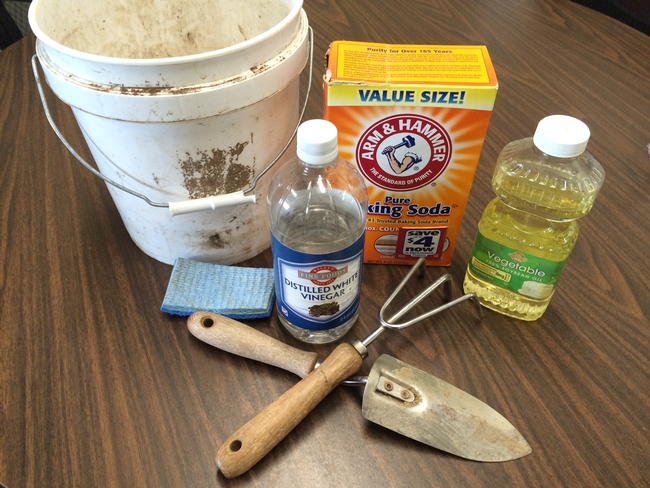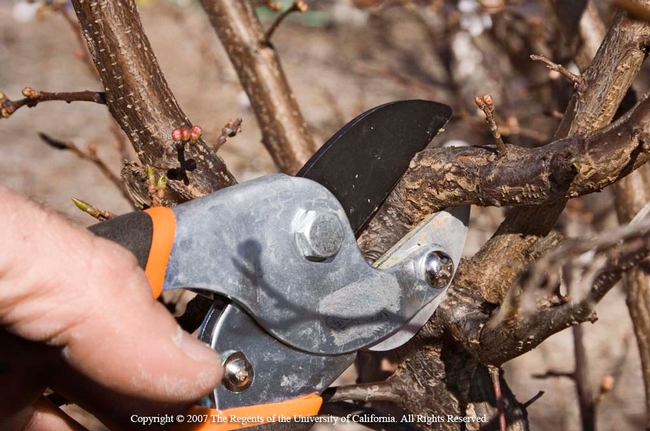
Posts Tagged: tools
“There’s no point in having a dull knife (pun intended)”
Sadly, there are a lot of dull, rusted tools out there, even on productive farms. If you watch the videos at the end of this post, you will hear “Rust is always a sign of neglect” so let this be the end of neglect. Put your tools “to bed for the winter,” or prepare them for pruning season, right around the corner.
There are three main parts of tool maintenance: clean, sharpen, and lubricate. These three steps should simply be done, in that order, every single time a tool is put back in the shed. The more often you do it, the easier and more effective it is at improving the lifespan of your tools.
Clean: There are three steps - cleaning off debris, removing rust, and sanitizing to prevent the transfer of disease. Proper cleaning may require removing screws and partially dismantling the tool.
Clean – Pressurized water, or a wire brush and a little soapy water are effective when used to scrub off all dirt and debris from your tool.
Rust? – Sometimes, especially if your tools have not been constantly maintained properly, you may see a rusted tool that just isn't what it used to be. Don't worry, if you have this problem, there are some easy tips that can help take that rust off. Spray the tool with vinegar, wrap in a paper towel and cover in plastic for about three hours, up to 24 hours. Remove the paper towel and plastic. Use a brush, an old toothbrush works just fine on small projects, put some baking soda in water and use the brush to scrub off the rust. Turpentine and steel wool also work well. After you scrub the tool to remove the rust, rinse thoroughly with water.
Sanitize – To ensure your tools are not going to spread disease around your farm, sanitation is important. Wipe down the tool surface with a 10% bleach solution (10 parts water to 1 part bleach), leave it for 30 seconds and then rinse thoroughly with water. Be sure to dry and oil your tool after sanitizing to be sure it does not rust from the bleach! Learn how below.
Sharpen: Many tools, even though you may not think of them as having a blade, actually require frequent sharpening to ensure their consistent function. A shovel, for instance, needs sharpening on the edge, which helps cut through roots, make clean holes, among other things. The basic method of sharpening is pretty simple. Use caution when sharpening and be sure to wear the proper protective equipment, such as gloves and eye protection.
Stabilize – Small tools, such as hand pruning shears, may easily be held firmly with the non-dominant hand. Larger tools, such as mower blades, or loppers, may need to be held in a vise.
Sharpen - Locate the proper edges to sharpen. Remember that there is a cutting blade and a bypass edge on some tools like pruning shears. You only need to sharpen the blade. A file can be used and should only be pushed in one direction. Hold the file at an angle, usually 45 degrees to the blade. Be sure to lubricate the blade and properly tighten screws after sharpening.
If you would like to pay a professional to sharpen your tools, at our January 9th Farmer-to-Farmer Breakfast, Ruben with Sharpening Tech will available to sharpen tools. Watch for an announcement on the Foothill Farming Calendar.
Lubricate: It is very important to oil your tools, even if they do not need to be sharpened. Oil helps keep the rust at bay. If your tool comes in contact with food crops or soil, we recommend a plant-based oil, like linseed oil for wood handles, and vegetable oil for pruners and shovels. This should happen each time your tools are put away. A barrel or bucket with sand and a small amount of oil left near your tool shed will work. Simply stabbing the tool in and out of the sand mixture can remove debris and oil the tool at the same time.
Store your tools standing upright or hanging, this also helps prevent rust. Develop a system to maintain your tools and always have them in their correct place so that anyone working in your operation can find the right tool anytime. Livestock Advisor Dan Macon has developed a system of sharpening his tools and oiling all the handles on New Year's Eve each year. He also prepared a lambing box, and outfits it with sufficient supplies and freshly sharpened tools each year before lambing season. What systems do you use, or need to use, to be prepared in your operation?
Video Resources:
How to Easily Clean Rusted Gardening Tools – Organically! – Learn to use vinegar and baking soda to remove old rust from your hand tools. https://www.youtube.com/watch?v=jtdDotcHnl4
Sharpening Tools – Pruners, Loppers, Shovels and More! – GrowOrganic.com – Tips to properly clean, sharpen, and store your hand tools to improve their life and performance. https://www.youtube.com/watch?v=yn8npWqkCa8
How to Replace a Shovel Handle - Wranglerstar.com – A detailed, step by step demonstration on how to properly replace a broken shovel handle with a new one. https://www.youtube.com/watch?v=j5UH0Y4KurY
Building a Tool: discoveries along the way
First of all, it’s not your typical farm tool. It isn’t a hoe, or a shovel, or even a tractor implement. But, it may help you harvest faster, increase your production, and lead to greater profits. By now, with the dawn of agriculture some 12,000 years or so behind us, it is reasonable to believe that every tool we really need has already been invented. Of course, there can never be enough variations of the hoe in the minds of the tool manufacturers. However, during the past several months, I have noticed a gap in the pantheon of farm tools.
The type of tool I’m talking about is a financial tool. Try though I may, I just cannot find a tool for small-scale farmers that help them address costs of production, profit margins, gross margin ratios, and other metrics in an accessible, comprehensive, and (this last part is very important) farmer-friendly manner. If I am remiss in my search, please let me know ASAP. However, I suspect that I am not. I have come across many books that either over-simplify this process, or address important accounting/book-keeping concepts while leaving out a comprehensive analysis of the operation in a (again, very important) farmer-friendly format.
In plain terms, here’s what I find lacking. Every small-scale farming operation here in Placer and Nevada Counties produces more than one crop. For an operation that produces one crop, it is very easy to get at the costs of production, profit margin, gross margin ratio, etc for that particular crop. However, when the farm starts to add crops to that list, the challenge of isolating these metrics becomes increasingly complicated. Any literature about this tries to address the problem by presuming that these crops exist by themselves, as if they were a one-crop operation. They do not.
In short, I seek to create a tool that can generate various metrics for a given crop, in the broader context of the operation as a whole. Translation: I am building a tool that will allow a farmer to know metrics for their carrots, beets, lettuce, broccoli, and whatever else they grow. I feel it’s a necessary step for farmers to be able to run a profitable business, and thus continue to farm.
Why is this important? Well, farmers may be selling their crop under their costs of production. For instance, through this process, I learned that for several years I was wholesaling bunched carrots for less than it took me to get them to market. Ouch. Maybe that’s why I was not hitting my salary goals! How many farmers are like me? Perhaps none. Perhaps several. Yet, I would guess the answer is that most farmers have this issue.
If you are a farmer, I recommend that you not be afraid of your numbers. Every little bit will help you and your business to succeed, and knowing your numbers may give you a measure of control in an otherwise unpredictable industry.
Tools For a Small Farm
Tools. I love tools, and when you are farming you need really good tools and lots of them. When most people think about the tools used on a farm, they think tractor. Tractors! I love tractors, but when you are farming on a small scale, you really don‘t use tractors all that often. In fact, buying a four wheel tractor when you are farming on a small scale can be a fatal financial mistake. Big farms use tractors all the time because they have to. Tractor mounted equipment is the only way to keep hundreds of acres tilled, weeded and harvested. Buying a tractor (new or used) requires a large outlay of precious farm capital and the return on your investment is low if you farm a small amount of land. Tractors earn their keep by working ground, not by sitting in the machine shed. Profit margins are usually small on farms, and if you spend all of your cash flow paying off an equipment loan, you are not going to have enough income to meet other expenses and you will be unable to pay yourself a living wage. No one should work for free, including the small farmer!
I farm about three acres give or take an acre or two, depending on the season. Summer takes more acres than winter due to all the sprawling crops like melons and squash that eat up space and force the farm to get bigger in acreage. Winter crops are more space efficient: the very nature of the plants allows them to be grown closely together. To farm three acres, hand tools rule the day.
Here is a list of what I consider to be the essential hand tools to work the soil and control the weeds for small scale agriculture (e.g. one to five acres):
- A good walk behind tractor with a tiller. The best ones are made in Italy. I drive a Ferrari when I am out in the fields. Notice that I said “walk behind tractor.” Yes, you can change attachments on these machines and use them for as many tasks as you own attachments (anything from mowing to baling hay).
- Wheel hoe: I love this tool! What is it? Well, that is hard to explain, but basically it is a swivel hoe attached to a frame with a single wheel in front and plow type handles for the operator. These tools work really fast, taking out small weeds in the walkways between crop beds and for the areas between rows of plants. They have interchangeable attachments and allow one person to cover a lot of ground quickly.
- Swivel hoes (also known as “hula hoes”): these tools have a square shaped head that has a narrow cutting blade that swivels back and forth. There are lots of different sizes and I think you should have at least three sizes: a three-inch wide, five-inch wide, and a seven-inch wide head. I use these to kill weeds between plants in both directions: across the bed, and down the length of the bed.
- An assortment of small hand tools, ranging from masonry trowels with the point cut off for transplanting, to Nantucket welders that allow close in weeding of young plants, to Japanese hoes with razor sharp carbon steel blades for really fine weeding when you don’t want to move the soil around too much.
These are the basics, but like anything else, the basics are the essentials upon which everything else is built. I use these tools more than any of the other items in the toolshed.


